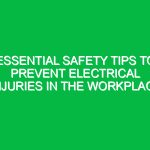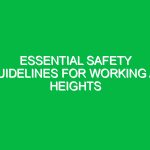Introduction
In today’s world, understanding why PPE (Personal Protective Equipment) is important cannot be overstated, especially in the context of Health, Safety, and Environment (HSE) management. PPE serves as the last line of defense against various workplace Hazards that can lead to injuries, illnesses, and even fatalities. It encompasses a wide range of equipment designed to protect workers from physical, chemical, electrical, and biological Hazards. As industries evolve and new risks emerge, the role of PPE becomes increasingly crucial in ensuring a safe and healthy working environment. This article aims to explore the significance of PPE within the HSE domain, detailing its importance, benefits, regulations, and Best Practices.
The Importance of PPE in HSE
Understanding the Basics of PPE
PPE includes various items such as helmets, gloves, goggles, earplugs, respiratory masks, and protective clothing. These items are essential in mitigating risks that workers face daily, particularly in high-risk environments like construction sites, laboratories, manufacturing plants, and healthcare facilities. The primary role of PPE is to reduce exposure to hazards that may lead to serious health issues or injuries. By wearing appropriate PPE, workers can carry out their tasks more safely, contributing to overall operational efficiency and productivity.
Key Aspects of Why PPE is Important
The necessity of PPE is underscored by several key aspects:
- Risk Mitigation: PPE significantly reduces the likelihood of injuries or illnesses caused by workplace hazards.
- Regulatory Compliance: Many industries are governed by strict health and Safety Regulations that mandate the use of PPE.
- Employee Confidence: Providing proper PPE helps employees feel safe, which can enhance morale and job satisfaction.
- Cost-Effectiveness: Investing in PPE can save companies money in the long run by preventing costly accidents and associated liabilities.
Real-Life Examples of PPE in Action
Consider a construction site where workers are exposed to falling debris. Without hard hats, the risk of head injuries increases dramatically. A case study conducted by the Occupational Safety and Health Administration (OSHA) revealed that proper helmet use reduced head injury rates by over 60%. Another example can be found in the healthcare sector. During the COVID-19 pandemic, the use of masks, face shields, and gowns was crucial in preventing the spread of the virus among healthcare workers. These instances highlight that PPE is not just a regulatory requirement but a vital component of Workplace Safety that can save lives.
The Benefits of PPE
Enhanced Worker Safety
The primary benefit of PPE is enhanced worker safety. By providing protection against potential hazards, employees can perform their jobs with greater peace of mind. For example, in chemical plants, wearing gloves and goggles can prevent skin and eye damage from corrosive substances. In construction, safety harnesses prevent falls from heights, significantly reducing the risk of severe injuries.
Legal and Financial Protection
Compliance with health and safety regulations is not only a moral obligation but also a legal one. Employers who fail to provide adequate PPE can face severe penalties, including fines and lawsuits. Furthermore, accidents resulting from inadequate Safety Measures can lead to significant financial losses due to medical expenses, compensation claims, and lost productivity. By prioritizing PPE, companies protect themselves from these potential liabilities.
Promotion of a Safety Culture
Implementing a robust PPE program fosters a culture of safety within the organization. When employees see their employer investing in their safety, it encourages them to adopt safe work practices. This culture of safety is crucial for minimizing risks and enhancing overall workplace morale.
Best Practices for PPE Usage
Conducting a PPE Assessment
To understand why PPE is important, organizations must first conduct a thorough risk assessment. This involves identifying potential hazards and determining the appropriate PPE required for different tasks. For instance, a construction site may require hard hats, Safety Goggles, and steel-toed boots, while a laboratory may need gloves and face shields.
Training and Education
Equipping employees with PPE is not enough; they must also be trained on how to use it effectively. Training sessions should cover the correct usage, maintenance, and limitations of PPE. Regular refresher courses can help reinforce this knowledge and keep safety at the forefront of employees’ minds.
Regular Inspections and Maintenance
PPE must be regularly inspected and maintained to ensure it remains effective. Employers should establish a maintenance schedule and encourage employees to report any damaged or worn-out equipment. For example, a harness used in construction must be checked for frays or tears that could compromise safety.
Hazards and Risks Associated with Inadequate PPE
Understanding Workplace Hazards
Inadequate PPE can expose workers to various hazards, including physical injuries from falls, cuts, and abrasions. Additionally, chemical hazards can lead to Burns or respiratory issues if proper protective equipment is not worn. The consequences of neglecting PPE can be dire, resulting in both immediate injuries and long-term health Effects.
Case Studies of PPE Failures
One notable case involved a manufacturing plant where employees were required to work with toxic chemicals without adequate respiratory protection. As a result, several workers developed chronic respiratory conditions that significantly affected their quality of life. This scenario exemplifies the critical importance of PPE in safeguarding worker health and well-being.
Regulations and Standards Governing PPE
osha and PPE Standards
In the United States, the Occupational Safety and Health Administration (OSHA) sets forth regulations regarding the use of PPE in the workplace. OSHA standards require employers to assess hazards, provide appropriate PPE, and ensure its proper use. Non-compliance can result in significant fines and legal repercussions.
International Standards
Globally, various organizations, such as the International Organization for Standardization (ISO), set standards for PPE. Understanding these regulations is crucial for organizations operating in multiple countries, as compliance ensures the safety of workers across different jurisdictions.
Conclusion
In conclusion, the importance of PPE in the Health, Safety, and Environment domain cannot be emphasized enough. By mitigating risks, ensuring regulatory compliance, and fostering a culture of safety, PPE plays a crucial role in protecting workers from potential hazards. As industries continue to evolve, so too must our approach to Workplace Safety, with PPE at the forefront of these efforts. Organizations must commit to providing adequate PPE, training employees, and maintaining equipment to ensure a safe working environment. Ultimately, investing in PPE is not just about compliance; it is about valuing human life and well-being. Employers and employees alike must prioritize safety, recognizing that a proactive approach to PPE can lead to a healthier, safer, and more productive workplace for everyone.


